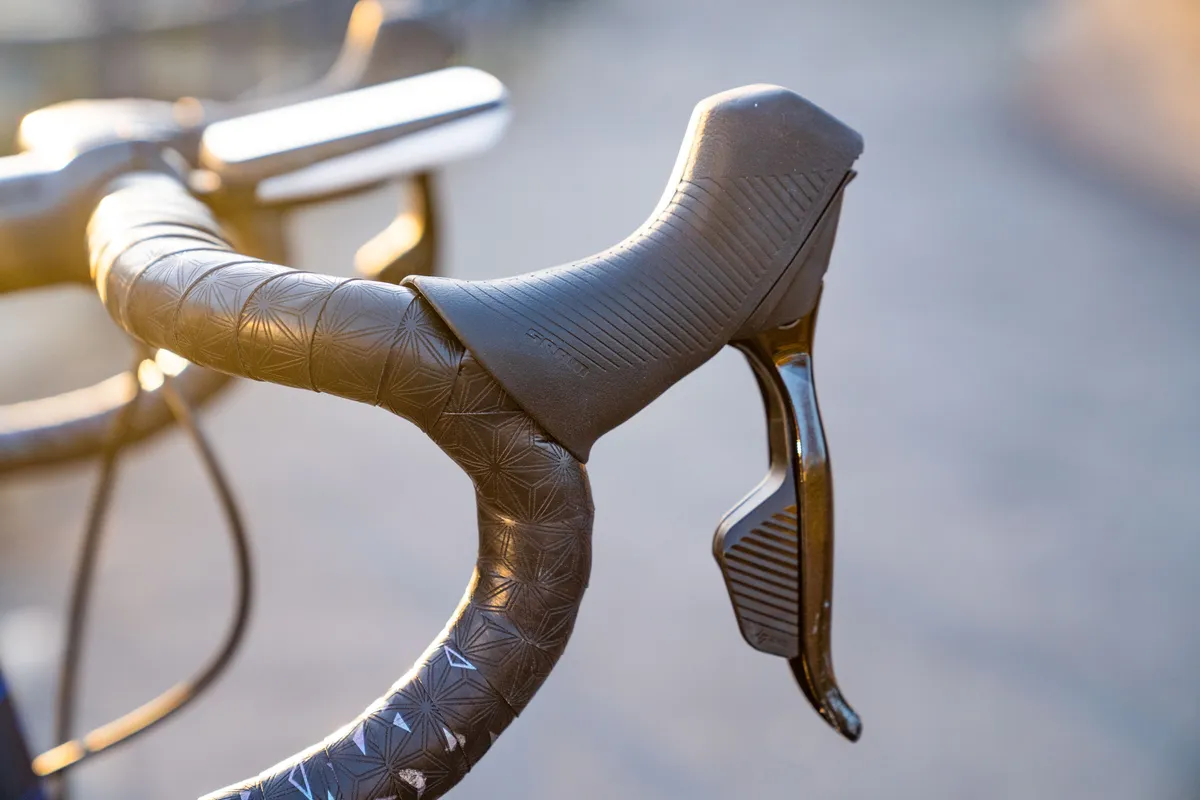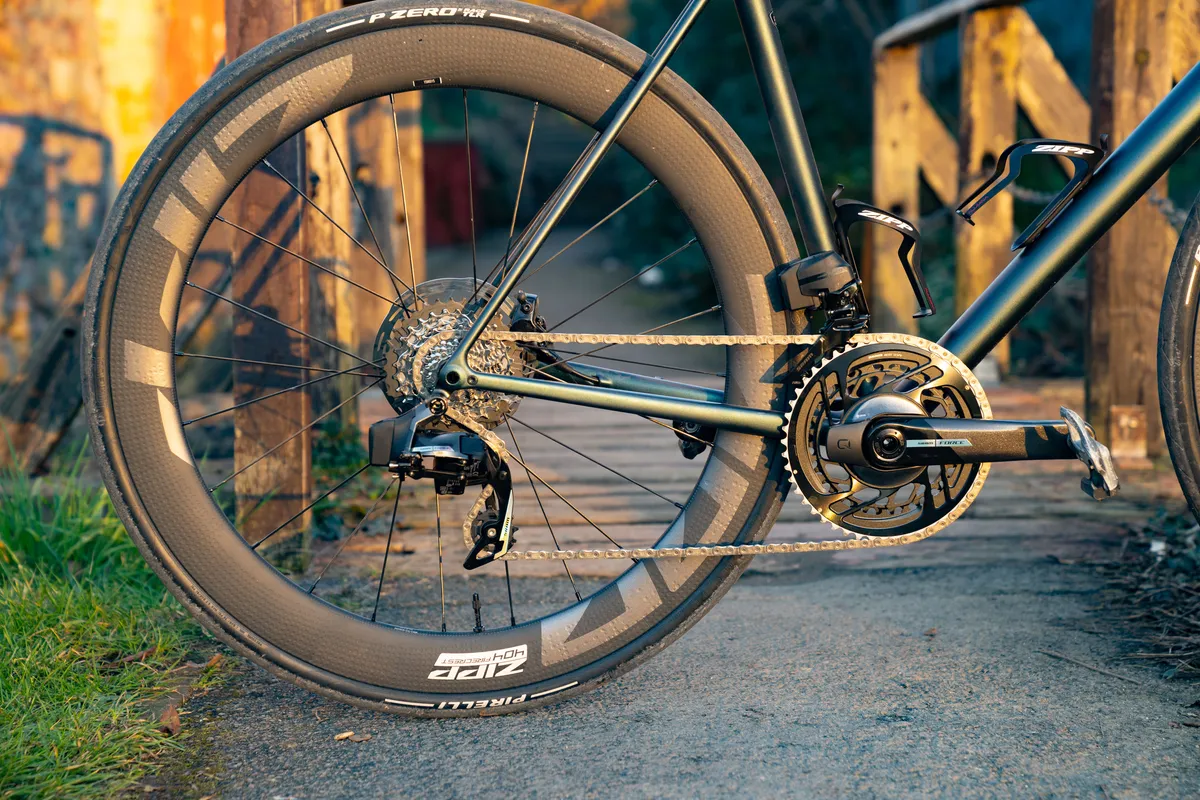The new SRAM Force eTap AXS groupset sees updates to the shifters, cranksets and front derailleur, alongside new shiny graphics.
There is a change to naming conventions, with SRAM dropping eTap from the groupset’s name – so, henceforth, it’s just SRAM Force AXS.
SRAM has made minimal or no changes to many of the other components for the second generation of its second-tier 12-speed electronic road bike groupset.
SRAM introduced Force eTap AXS 12-speed in 2019, not long after its range-topping Red eTap AXS. Force eTap AXS shares many of the features of the Red wireless 12-speed groupset, but at a more affordable price.
In April 2021 Rival eTap AXS was released. It’s fair to say Rival has taken up a lot of the space occupied previously by Force, with many brands promoting Rival eTap AXS as an electronic groupset option on their mid-tier bikes.
Here, we’ll run through the each of components of the second-generation Force AXS 12-speed groupset, their weights and prices.
How does the new groupset ride? You can read our SRAM Force AXS first ride review to find out.
The 6 key things you need to know about new SRAM Force AXS
- Full range of different groupset configurations to suit different riding styles: double-chainring, single-ring, double-ring Wide, single-ring Wide and XPLR
- Redesigned shifters are more compact but lose brake bite point adjustment and wired Blips compatibility
- Standard chainset and power meter are, like Red, one-piece direct mount, without a separate spider and bolt-on chainrings
- Revised front-derailleur geometry for claimed snappier shifting
- Still compatible with components from all other AXS-enabled road and MTB groupsets
- New shiny graphics
SRAM Force AXS chainset

Apart from the new graphics, the biggest change seen with SRAM Force AXS groupset is in the new range of standard 1x and double cranksets and power meters.
These now look (and functionally) are much more like Red-level chainsets, just without the shiny highlights.
The cranksets (but not the Wide double-chainring option) have gone from using separate chainrings bolted to a crank-arm spider, to one-piece units like those used by SRAM Red. They use SRAM’s direct-mount interface to connect to the cranks.
SRAM says this increases the stiffness as well as making for a lighter, more durable unit. For the double-ring option, this means you need to replace both chainrings as a unit and you can’t just buy a single chainring if you want to change your ratios.

There are power meter options across the range of configurations. As with Red, the double-sided power meter is integrated into the chainrings for the double-chainring non-Wide option. This means if you need to replace the chainrings on a power meter chainset, you need to replace the power meter as well.
As with the Red power meter, SRAM will offer a 50 per cent trade-in deal on a new power meter with the same ratios.
There’s also the option to buy a left-side crank arm, single-sided power meter that’s the equivalent of the Rival AXS power meter, but with the arm made from carbon fibre and matching the rest of the Force AXS groupset.
Apart from the non-Wide double-chainset power meter, which measures separate left- and right-side power, all SRAM’s other Force-level power meters are single-sided, measuring left-side power only.
SRAM Force AXS two-chainring chainset/power meter

The standard SRAM Force AXS double chainset has carbon fibre crank arms with the new, high-gloss Force look and runs on a DUB bottom bracket. It’s available in 50/37t, 48/35t and 46/33t options and is upgradeable to a power meter. Crank lengths run from 165mm to 177.5mm.
You can buy the chainset with a double-sided power meter ready-fitted, or you can also buy the power meter as a separate add-on to a non-instrumented chainset. Both have a claimed accuracy of +/- 1.5 per cent.
- Power meter price (without BB): £772 / $800 / €856
- Non-power meter price (without BB): £295 / $275 / €330
SRAM Force AXS Wide two-chainring chainset/power meter

The Wide option hasn’t changed from the previous-generation Force Wide, except for its graphics. As previously, it moves the chainline 2.5mm outboard from the standard chainset to provide greater tyre clearance and offers a 43/30t chainring combination aimed at gravel riders.
The SRAM Force AXS Wide chainset uses a separate crank spider and chainrings, rather than the integrated unit of the standard double chainset. There’s a single-sided power meter option that SRAM says adds less than 40g of extra weight.
- Power meter price (without BB): £565 / $585 / €632
- Non-power meter price (without BB): £295 / $275 / €330
SRAM Force 1 AXS single-chainring chainset/power meter

Like the double-chainring option, the (standard spacing) Force 1 AXS chainset is available with or without a power meter and uses a direct-mount, spiderless chainring.
It's available with a 38t, 40t, 42t, 44t, 46t, 48t or 50t chainring. The 48t and 50t options are aero profile. Unlike the double-chainring power meter, the instrumented version measures left-side power only.
- Power meter price (without BB): £565 / $585 / €632
- Non-power meter price (without BB): £295 / $275 / €330
SRAM Force 1 AXS Wide single-chainring chainset/power meter

Finally, the SRAM Force 1 AXS Wide chainset, like the double-chainring option, shifts the chainline to the right. It’s compatible with 135mm, 142mm or Boost rear-axle spacing and with road or MTB bottom brackets. The power meter option is single-sided and measures left-side power only. Chainring sizes available are 38t, 40t, 42t, 44t and 46t.
- Power meter price (without BB): £565 / $585 / €632
- Non-power meter price (without BB): £295 / $275 / €330
SRAM Force AXS HRD shifters

SRAM has scaled down the Force AXS shifters, with the new generation getting a more compact body and a profile with ribbed hoods for grip. SRAM says this makes them easier to use for a wider range of hand sizes. The reach can also be adjusted, although the bite point adjustment for the brakes present in the previous generation of levers has been removed.
The new design is comparable to Rival AXS, but with a carbon brake lever, rather than Rival’s alloy version.

The shift paddle has been redesigned to make it easier to use, with less risk of pinching fingers, and the lever has the new Force graphics. It's powered by a single CR2032 coin cell per shifter, which SRAM says will give around two years of shifting.
As with Rival AXS, SRAM has also reduced the range of extras the levers can work with, so you can’t use wired Blips satellite shifters, only the wireless version, with up to three sets linkable to the derailleurs.

The brake caliper and hose, but not the rotor, are included with the shift/brake lever assembly. SRAM revised its construction method for the new-generation calipers via a rolling change in early 2020. Otherwise, the design hasn’t changed.
These are now made in two parts, rather than a single piece, which SRAM says allows more accurate machining of the piston bores. It says this in turn leads to better piston retraction after prolonged braking and that it should lead to less brake rub.
- Price (each): £228 / $350 / €255
SRAM Force AXS rear derailleur

Aside from its new graphics, the rear derailleur is the same as the previous generation, with a built-in Orbit fluid damper that SRAM says ensures chain retention and quieter running. It’s compatible with single and double chainrings, and with cassettes with a largest sprocket between 28 and 36 teeth.
As with the older Force rear derailleur, it’s the brains of the outfit, with buttons to enable you to access trim adjustment and configure the groupset from the AXS phone app.
- Price (w/o battery): £302 / $377 / €360
SRAM Force XPLR AXS rear derailleur

The XPLR rear derailleur also carries over the functionality of its predecessor, enabling you to run either a 10-36t or 10-44t cassette with a single-ring chainset.
- Price (w/o battery): £306 / $369 / €343
SRAM Force AXS front derailleur

Along with its redesigned double-ring chainset, SRAM has also made subtle changes to the profile of the front derailleur cage. This still has the yaw design that means, unlike Shimano Di2 front derailleurs, the derailleur doesn’t need to trim its position as you shift up and down the cassette.
The new cage design should also reduce chain rub and make for quieter shifting, SRAM says.
- Price (w/o battery): £198 / $243 / €222
SRAM Force AXS Wide front derailleur

Riders running the Wide double chainset will need a Wide front derailleur to match the wider chainline. The Wide front derailleur enables increased tyre clearance and is designed to work with the Wide chainset’s 43/30t chainrings.
- Price (w/o battery): £198 / $243 / €222
New four battery charger

The standard SRAM AXS battery charger takes a single battery only, but for the power-hungry, there’s a new four-slot option with a USB-C connector that recharges four batteries in 60 minutes, the same time as for one battery on the current single battery charger. It’s even faster if you don’t use all four slots, and there’s a fast charge option to get batteries up to 75 per cent capacity.
- Price: £130 / $120 / €145
SRAM Force AXS groupset weights

Here are the weights for each component and the complete groupset, based on a double chainset with standard spacing and a pair of Paceline rotors.
- Rear derailleur (incl battery): 328g
- Front derailleur (incl battery): 182g
- Crankset: 746g
- Shifters (pair): 468g
- Cassette: 273g
- Chain: 241g
- Brake rotors (pair): 320g
- Total: 2.7kg
SRAM Force AXS groupset pricing info
With so many potential configurations, there’s a broad range of prices. For a road bike with a double chainset and no power meter, here are the component prices and total cost for the new Force AXS groupset.
| Price UK | Price US | Price Europe | |
|---|---|---|---|
| Rear derailleur | £302 | $377 | €360 |
| Front derailleur | £198 | $243 | €222 |
| 2x batteries | £112 | $118 | €126 |
| Crankset | £295 | $275 | €330 |
| Bottom bracket (BB86) | £42 | $46 | €50 |
| Shifters (pair) | £456 | $700 | €510 |
| Cassette | £179 | $195 | €200 |
| Chain | £36 | $50 | €60 |
| Brake rotors (pair) | £108 | $172 | €94 |
| Total price without power meter | £1,728 | $2,176 | €1,952 |
| Power meter | £772 | $800 | €856 |
| Total price with power meter | £2,205 | $2,701 | €2,478 |
We reckon the total price of the components in the groupset is £1,728 in the UK, $2,176 in the US and €1,952 in Europe. That’s comparable to the full suggested retail price of Shimano 105 Di2 12-speed and significantly undercuts the price of Shimano Ultegra R8170 12-speed.
Add in a power meter and the sum of the component prices rises to £2,205 / $2,701 / €2,478.
SRAM quotes a double-chainring groupset price of £1,751 / $2,115 / €1,980 for the complete groupset without a power meter and £2,228 / $2,640 / €2,515 with a power meter, excluding the bottom bracket.
